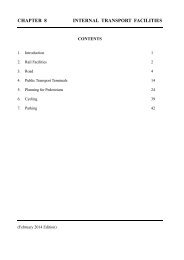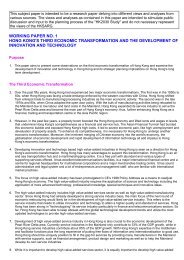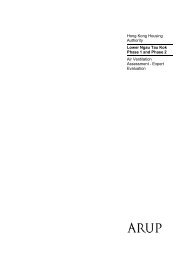download PDF version [5.1 MB]
download PDF version [5.1 MB]
download PDF version [5.1 MB]
You also want an ePaper? Increase the reach of your titles
YUMPU automatically turns print PDFs into web optimized ePapers that Google loves.
CONTENTS<br />
Page No.<br />
Introduction<br />
Objectives of the Fourth Review<br />
Main Tasks of the Fourth Review<br />
The Study Process<br />
Hong Kong Port Cargo Forecasts<br />
2000/01<br />
Requirements for Cargo Handling<br />
Facilities<br />
Requirement of Other Port Related<br />
Facilities<br />
Identification of Sites for New Container<br />
Terminal<br />
Intermodal Links to the Port<br />
Long Term Strategic Development<br />
Issues<br />
Way Forward<br />
1<br />
2<br />
3<br />
4<br />
5-6<br />
7-11<br />
12-15<br />
16-21<br />
22-23<br />
24-25<br />
26
Introduction<br />
The Port and Airport Development Strategy<br />
(PADS), completed in 1989, set out an<br />
overall long-term planning framework for<br />
port and airport development in Hong Kong.<br />
Since then, three Port Development<br />
Strategy Reviews (PDSR) had been carried<br />
out to ensure that Hong Kong’s port development<br />
can keep up with the times and<br />
global development, and can maintain a<br />
competitive position. The current fourth<br />
review (Port Development Strategy Review<br />
2001(PDSR2001)), carried out in-house by<br />
the Port and Maritime Division of the<br />
Economic Services Bureau (PMD/ESB),<br />
the Planning Department and the Marine<br />
Department, seeks to update the Third<br />
PDSR based on the report findings of the<br />
Port Cargo Forecasts (PCF) 2000/01<br />
(completed in Feb. 2001).<br />
1
Objectives of the Fourth<br />
Review<br />
The primary objective of the<br />
study is :<br />
to form an updated port facility<br />
development strategy so as to provide<br />
a conceptual planning framework for<br />
the future development of port facilities<br />
and timely reservation of land for those<br />
facilities.<br />
2
Main Tasks of the Fourth<br />
Review<br />
In order to achieve the objectives,<br />
the study comprises the following<br />
main tasks:<br />
( i)<br />
( ii)<br />
( iii)<br />
( iv)<br />
( v)<br />
( vi)<br />
to take stock of the existing/planned<br />
port and port related facilities;<br />
to update the productivity levels in<br />
cargo handling of various port facilities;<br />
to update the assumptions on the<br />
distribution of ocean and river cargo<br />
handled at various port facilities;<br />
to translate findings of the above tasks<br />
by taking account of the results of the<br />
PCF 2000/01, and to update demand<br />
for port and port-related facilities;<br />
to review the supply and demand situation<br />
of off-port container back-up<br />
land; and<br />
to broadly identify potential sites for<br />
long-term development of port<br />
facilities.<br />
( i)<br />
( ii)<br />
( iii)<br />
( iv)<br />
( v)<br />
( vi)<br />
3
Hong Kong Port Cargo Forecasts 2000/01<br />
The Port Cargo Forecasts (PCF) 2000/01 is the main input to the PDSR 2001. It is to review<br />
and update the port cargo forecasts up to the year 2020 by taking account of past port traffic<br />
pattern, macro-economic context, impact of Mainland’s accession to the World Trade<br />
Organization (WTO), development in the Pearl River Delta (PRD) region, direct trade link<br />
between Mainland and Taiwan, determinants of cargo routing and Hong Kong’s port<br />
competitiveness.<br />
As compared with the previous PCF 1997/98, PCF 2000/01 predicted a slightly higher<br />
magnitude of total container traffic (Table 1). The comparison of the two PCFs is shown in<br />
Figure 2. The higher throughputs projected in the 2000/01 forecast are mainly due to the<br />
anticipated strong export growth of Southern part of the Mainland , which will be further boosted<br />
by the Mainland’s accession to the WTO.<br />
Hong Kong port is forecast to become increasingly reliant on cargo originating from the PRD<br />
area as the main source of cargo. The volume of containers carried by ocean-going vessels<br />
is forecast to reach 30.2 million TEUs by 2020 and another 10.4 million TEUs will be handled<br />
by river trading vessels. This reflects a gradual increase in the share of river containers from<br />
24 % in 1999 to 26 % in 2020.<br />
5
Table 1 : Comparison of PCF 97 / 98 and PCF 2000 / 01<br />
海 運 貨 物<br />
Ocean<br />
河 運 貨 物<br />
River<br />
( 百 萬 個 標 準 貨 櫃 單 位 )<br />
(Million TEUs)<br />
合 計<br />
Total<br />
年 份<br />
Year<br />
港 口 貨 運<br />
量 預 測<br />
PCF<br />
97/98<br />
港 口 貨 運<br />
量 預 測<br />
PCF<br />
2000/01<br />
港 口 貨 運<br />
量 預 測<br />
PCF<br />
97/98<br />
港 口 貨 運<br />
量 預 測<br />
PCF<br />
2000/01<br />
港 口 貨 運<br />
量 預 測<br />
PCF<br />
97/98<br />
港 口 貨 運<br />
量 預 測<br />
PCF<br />
2000/01<br />
1999 13.8 12.3 3.2 3.9 17.0 16.2<br />
2001 14.4 14.4 3.9 5.2 18.3 19.6<br />
2006 18.2 17.6 5.9 7.7 24.1 25.3<br />
2011 22.1 22.1 7.1 9.0 29.2 31.1<br />
2016 25.5 27.2 7.3 10.0 32.8 37.2<br />
2020 - 30.17 - 10.36 - 40.53<br />
Figure 2 : Comparison of PCF 97 / 98 and PCF 2000/01<br />
45<br />
40<br />
35<br />
30<br />
25<br />
20<br />
15<br />
10<br />
5<br />
0<br />
1999 2001 2006 2011 2016 2020<br />
河 運 River<br />
河 運 River<br />
年 份 Year<br />
海 運 Ocean<br />
海 運 Ocean<br />
6
Requirements for Cargo<br />
Handling Facilities<br />
Based on the projected distribution of port<br />
cargo to each of the cargo handling facilities<br />
and the assumed productivity of the<br />
facilities, the cargo volumes projected in the<br />
PCF 2000/01 are then translated into<br />
requirements for various port facilities,<br />
which include container terminals, midstream<br />
sites, river trade terminals and<br />
public cargo working areas.<br />
As there are inherent uncertainties of the<br />
future development like cargo share<br />
between Hong Kong and Mainland ports,<br />
different port throughput scenarios (i.e.<br />
Base, High and Low cases) have been<br />
derived from the PCF 2000/01 for<br />
sensitivity testing purposes. For the<br />
assessment of the future requirements for<br />
various cargo handling facilities, the “Base<br />
Case” of the PCF 2000/01 was adopted.<br />
The requirements for various cargo handling<br />
facilities are indicated in Table 2.<br />
7
Table 2 : Requirements for Various Cargo Handling Facilities<br />
Additional Facility<br />
新 增 設 施<br />
Year<br />
年 份<br />
2005 2010 2 0 1 5 2020<br />
Container Terminal Berth<br />
(assumed berth length=320m)<br />
貨 櫃 碼 頭 泊 位<br />
( 假 設 泊 位 長 度 =320 米 )<br />
0 2 9 13<br />
Mid-stream Berth 1<br />
(assumed berth length=55m)<br />
中 流 作 業 泊 位<br />
1<br />
( 假 設 泊 位 長 度 =55 米 )<br />
0 0 0 0<br />
River Trade Terminal Berth<br />
(assumed berth length=50m)<br />
內 河 碼 頭 泊 位<br />
( 假 設 泊 位 長 度 =50 米 )<br />
0 0 20 29<br />
1 On the assumption that two mid-stream sites will be provided in Tsing Yi South<br />
(ex power plant) and Tsing Yi Southeast by 2005.<br />
8
Container Terminals (CT)<br />
Based on the current PCF prediction, it is estimated that the first berth of the next Container Terminal<br />
(i.e. CT 10) will be required towards the end of this decade. At present, CT9 is being constructed on<br />
Tsing Yi. The first berth is expected to be available in 2002 and all six berths to be completed by<br />
2004.<br />
Sites originally earmarked for CTs 10 and 11 were lost to the development of the Disney Theme Park<br />
project. In view of the continuous cargo growth and in order to give more flexibility in planning Northeast<br />
Lantau to become a major tourism/recreation area, there is a need to consider other sites for container<br />
terminal.<br />
Our port policy seeks to ensure that port facilities can be provided in a timely manner to meet forecast<br />
demand. From a sustainable planning perspective, port operation places strain on the land resource,<br />
infrastructure system and environmental capacity of the territory. So we need to assess if the physical<br />
and environmental capacity of Hong Kong could cater for the growth of economic activities which are<br />
relying on cargo trade. The follow-up study will assess the sustainable development implications,<br />
among other things,of building another container terminal.<br />
9
Mid-stream Sites (MSS)<br />
It is anticipated that the demand for MSS will<br />
be quite steady in the foreseeable future .<br />
Except the planned sites,no new sites are<br />
required for at least the next 10 years. The<br />
situation would be monitored and the demand<br />
and provision of sites would be reviewed from<br />
time to time.<br />
River Trade Terminals (RTT)<br />
With the full completion of the first Tuen Mun<br />
RTT in end 1999, it is expected that the<br />
second RTT would not be required until the<br />
next decade. The location of the second RTT,<br />
originally proposed at Northshore Lantau, has<br />
now been recommended for tourism/<br />
recreation use. To facilitate movement of<br />
containers, it is suggested that future river<br />
trade facilities should be provided as part of<br />
container terminal facilities. Accordingly, the<br />
future provision of river trade facilities would<br />
be investigated in conjunction with the<br />
proposed feasibility study for the container<br />
terminal (see Way Forward below).<br />
10
Public Cargo Working Areas<br />
(PCWA)<br />
The emergence of the first RTT has<br />
provided an alternative to PCWAs to pick<br />
up both river and bulk cargo. It is<br />
recommended that no new public cargo<br />
working area should be provided except for<br />
the reprovisioning of displaced facilities.<br />
However, finding replacement sites are<br />
extremely difficult now within the Victoria<br />
Harbour. Progressive implementation of<br />
PCWA Management Reform should be<br />
continued with a view to enhancing the<br />
productivity of PCWAs and thus reducing<br />
their requirement in the inner harbour. Due<br />
to the competing waterfront uses and the<br />
need to provide land for major<br />
infrastructure, open space and tourism<br />
related developments, the Government has<br />
notified the operators of Wan Chai,<br />
Western District, Kwun Tong and Cha Kwo<br />
Ling PCWAs that these PCWAs would be<br />
affected by development plans/projects in<br />
the respective areas.<br />
11
Requirement of Other Port<br />
Related Facilities<br />
Port Back-up (PBU) Land<br />
Gross land area taken up by PBU uses has<br />
now stabilized, and even declined from 364<br />
ha in 1997 to 331 ha in 2000 1 .It is estimated<br />
that the current and planned supply of PBU<br />
land could meet the demand for the next<br />
decade 2<br />
2<br />
1<br />
It is worth to note that efforts over recent<br />
years have helped to reduce the area of offport<br />
problematic sites, and improve the<br />
environmental aspects. Sites in suitable<br />
locations, including those in Kwai Chung,<br />
Tsing Yi and North Western New Territories,<br />
have been zoned for PBU uses, or tendered<br />
out for PBU uses through Short Term<br />
Tenancies. Supply of off-port PBU land<br />
would also come from temporary<br />
permissions through the planning application<br />
system, under which each application would<br />
be considered on its individual merits. For<br />
future container terminal, additional PBU<br />
land would be planned near to the new port<br />
facilities. In the long term, it is expected that<br />
some PBU services would be located in the<br />
Mainland.<br />
1<br />
Source : Survey on Container Back-up<br />
Land Use, 1998 and 2000,TFB,LandsD.<br />
2<br />
Source : Study on Port Back-up Facilities<br />
and Land Requirements,2000,P<strong>MB</strong>.<br />
12
Buoys and Anchorages (B&A)<br />
There are at present 59 buoys and 11<br />
anchorages designated for cargo working.<br />
The current demand represents about 50%<br />
of the supply and it is estimated that the<br />
surplus will drop to 20% by 2020. In view of<br />
this, it is recommended that the utilization<br />
of B&A should be further improved.<br />
Typhoon Shelter (TS)<br />
The PADS had recommended the<br />
development of TS at Hei Ling Chau, Siu<br />
Lam and Peng Chau to cater for the<br />
shortage. With the commissioning of the<br />
Hei Ling Chau TS last year, it is estimated<br />
that the next TS will not be required until<br />
after 2015.<br />
13
Ship Repair Yards<br />
It is found that the business of local ship<br />
repair yards have been declining over the<br />
past few years, mainly due to the<br />
competition from the Mainland. At present,<br />
the local ship repair industry has a 46%<br />
excess capacity and the excess is expected<br />
to gradually increase to 53% by 2016.<br />
There is no plan to introduce new sites for<br />
ship repair yards.<br />
Bunker Terminal and Bulk Cargo<br />
Terminal<br />
The commercial viability and market<br />
demand for bunker terminals and bulk<br />
cargo terminals should be further<br />
assessed. Should there be a market<br />
demand in future, the land requirement and<br />
location for such facilities would be further<br />
studied. Possible sites include Tuen Mun<br />
Area 38 and Tsing Yi Island.<br />
14
Logistics Facilities<br />
In his 2000 Policy Address, the Chief<br />
Executive announced his vision to<br />
develop Hong Kong’s logistics services<br />
to serve the entire PRD region.<br />
Recognising the complementary role of<br />
logistics facilities and port development,<br />
the“Study to Strengthen Hong Kong’s Role<br />
as the Preferred International and<br />
Regional Transportation and Logistics Hub<br />
in Asia” commissioned by the Port and<br />
Maritime Board was to assess, inter alia,<br />
the development potential for the<br />
establishment of “ Value Added Logistics<br />
Parks” 3 . Subject to confirmation of<br />
commercial viability and market demand,<br />
identifications of location for such facility<br />
would be undertaken. At present, the<br />
Hong Kong International Airport has<br />
already awarded<br />
development rights<br />
for a logistics center<br />
on the airport island.<br />
Other possible sites<br />
including the back-up<br />
land adjacent to CT9,<br />
Tuen Mun Area 38<br />
and Tsing Yi Island<br />
could also be<br />
considered for logistics<br />
development.<br />
3<br />
3<br />
Value Added Logistics Parks not only provide conventional warehousing services but perform value added logistics<br />
activities, time sensitive processing and e-commence. This requires the Value Added Logistics Parks to be served<br />
by multiple (land, sea, air) transportation modes.<br />
15
18<br />
Plan 1
A preliminary assessment of these four<br />
shortlisted sites based on the following<br />
set of criteria have been carried out. The<br />
results are shown in Table 3. The<br />
sustainability principles have been<br />
applied in the evaluation process of<br />
different site options.<br />
Locational Preference, Land and<br />
Marine Access: container terminal<br />
development at the site should be<br />
compatible with the surrounding<br />
land-uses, the site should have good<br />
intermodal links, good road access<br />
and easy access to deep marine<br />
channel;<br />
Environmental and Ecological<br />
Impact: the site should be<br />
environmentally acceptable;<br />
Size and Development Potential:<br />
the site should be able to<br />
accommodate future container<br />
vessels and have potential for<br />
expansion. Sites with sufficient land<br />
for off-terminal back-up and logistics<br />
centers development are considered<br />
to be more attractive;<br />
Economic Consideration and<br />
Investment Attractiveness: the<br />
site should be able to increase our<br />
port’s relative competitiveness and<br />
be attractive to potential investors;<br />
and<br />
Programme and Implementation:<br />
the site should be implementable and<br />
the development of the port facilities<br />
should be available in time to meet<br />
forecast demand.<br />
19
Table3 : General Performance of the Four Potential Sites<br />
West North-West<br />
South-West<br />
Site Criteria Tuen Mun Lantau East Lantau Tsing Yi<br />
選 址 準 則 屯 門 西 大 嶼 山 西 北 大 嶼 山 東 青 衣 西 南<br />
Locational Preference,<br />
Relationship with Adjacent<br />
Uses, Land and Marine<br />
Access<br />
位 置 是 否 適 合 、<br />
與 毗 鄰 用 途 的 關 係 、<br />
水 陸 交 通 聯 繫<br />
Fair to<br />
Good Poor Poor Good<br />
普 通 至 良 好 差 差 良 好<br />
Environmental and<br />
Medium<br />
Medium to<br />
Ecological Impact<br />
t o H i g h Significant High High<br />
環 境 和 生 態 影 響 中 至 高 極 高 高 中 至 高<br />
Size and Development<br />
Potential Fair Fair to Poor Fair Poor<br />
面 積 和 發 展 潛 力 普 通 普 通 至 差 普 通 差<br />
Economic Consideration and<br />
Investment Attractiveness Fair Fair Fair Fair<br />
經 濟 考 慮 和 投 資 吸 引 力 普 通 普 通 普 通 普 通<br />
Programme and<br />
Implementation Fair Poor Fair Very Poor<br />
發 展 進 度 和 實 施 普 通 差 普 通 甚 差<br />
.<br />
20
To ensure that the sustainable development<br />
and economic implications of<br />
container terminal development are fully<br />
examined, and to assess if the physical<br />
and environmental capacities of Hong<br />
Kong could cater for further port<br />
development,a follow-up study is required<br />
to examine in detail and recommend the<br />
best strategic option for developing and<br />
locating Hong Kong’s new container<br />
terminal facilities (see Way Forward<br />
below).<br />
21
Intermodal Links to the Port<br />
Hong Kong’s port handles 80% of Hong Kong’s total freight. It is estimated that close to<br />
80% of our container cargo come from the PRD Region of the Mainland. To maintain our<br />
competitive edge, we need to monitor the development and progress of various road,<br />
waterway and rail link projects that can increase the connectivity of our port to our cargo<br />
sources.<br />
Strengthening of the railway link will provide an opportunity for Hong Kong to gain deeper<br />
penetration into the inland cargo sources further north of the PRD Region.A Port Rail<br />
Line (PRL) has been proposed in the Railway Development Study 2000 (RDS-2000) which<br />
was completed in mid-2000. Kowloon-Canton Railway Corporation is examining its viability<br />
based on commercial consideration and the best way to take forward the proposal<br />
for the development of the PRL. Meanwhile, an administrative rail reserve has been<br />
drawn up to protect the alignment of the proposed rail.<br />
22
Long Term Strategic<br />
Development Issues<br />
In the long term planning of Hong Kong’s<br />
port facilities, a number of strategic development<br />
issues would need to be monitored<br />
and assessed. These include :-<br />
Mainland’s accession to WTO which<br />
would bring more trade and<br />
investment flows to the Mainland in<br />
the long term and hence would<br />
increase the area of cargo source<br />
and the volume of cargo flow passing<br />
through the Hong Kong port.<br />
Simultaneously, WTO accession<br />
would also speed up customs<br />
reforms in the Mainland, which would<br />
strengthen the competitiveness of<br />
Shenzhen ports.<br />
Development of the Western Region<br />
in the Mainland would bring about<br />
improvement to transport<br />
infrastructure and growth of<br />
manufacturing and trading activities<br />
in the Western Province in the long<br />
term. This would provide more<br />
business opportunities to Hong Kong<br />
businessmen and hence facilitate<br />
more cargo flow between these<br />
areas and Hong Kong.<br />
24
Transport infrastructure<br />
developments in the Mainland<br />
especially in the PRD Region would<br />
reinforce our linkages with the<br />
Mainland and facilitate cargo flows.<br />
Maintaining constant dialogue and<br />
communication with Mainland<br />
planning, port, transport and<br />
customs authorities, especially<br />
Shenzhen authorities, is essential.<br />
It helps both sides to understand<br />
more about each other’s future<br />
planning needs.<br />
Sustainable development is the key<br />
to a good quality of life. The future<br />
port development strategy would<br />
need to be based on the principle of<br />
sustainable development which<br />
seeks to balance social, economic<br />
and environmental needs. The<br />
sustainability implications of any<br />
future port expansion plans would<br />
need to be examined in the planning<br />
and development process.<br />
Hong Kong 2030 : Planning Vision<br />
and Strategy (HK2030) Study being<br />
carried out by the Government to<br />
update the previous Territorial<br />
Development Strategy Review<br />
(completed in 1998). The HK2030<br />
Study provides a long term land usetransport-environment<br />
planning<br />
framework for Hong Kong in the next<br />
30 years. The PDSR 2001 will form<br />
an input to scenario testing in the<br />
HK2030 Study.<br />
25
Way Forward<br />
A follow-up study should be commissioned to recommend the best strategic option for<br />
locating and developing Hong Kong’s new container terminal facilities outside the Kwai<br />
Chung basin. Further river trade facilities should be incorporated in the future container<br />
terminal development. This study should also take into account rapidly changing<br />
developments in the shipping and logistics industry and the demand from port users for<br />
the capability to handle mega vessels and for a “total logistics solution” to meet their<br />
logistics needs within the global supply chain.<br />
Market conditions are changing fast. Uncertainties in forecasting port cargo volume mean<br />
that timely knowledge is critical to successful port planning. It is proposed that the next<br />
review of PCF and PDSR should be updated every two years instead of three. The PCF<br />
and PDSR are suggested to be carried out in 2003 so that the timing of the requirement<br />
for new container terminal development could be further assessed before a final decision<br />
is made on plan for new container terminal facilities.<br />
26


![download PDF version [5.1 MB]](https://img.yumpu.com/33110253/1/500x640/download-pdf-version-51-mb.jpg)
![download PDF version [2.6 MB]](https://img.yumpu.com/51515637/1/190x135/download-pdf-version-26-mb.jpg?quality=85)
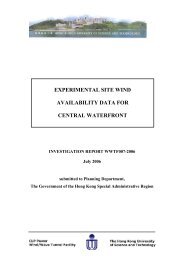
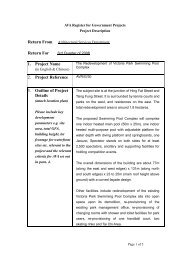

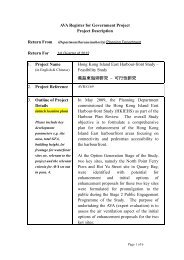
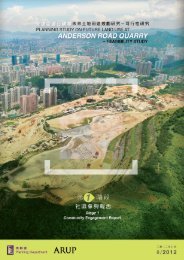
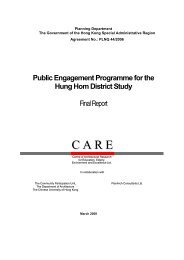
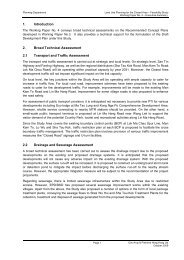
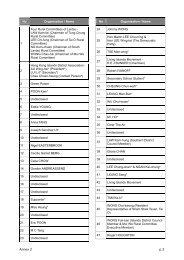
![download PDF version [950 KB]](https://img.yumpu.com/41776329/1/184x260/download-pdf-version-950-kb.jpg?quality=85)
